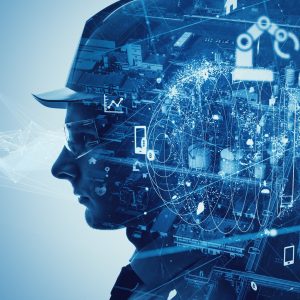Artificial Intelligence (AI) in manufacturing has rapidly moved into the mainstream conversation. Market research firm IDC says global spending on AI (all industries) was $19.1 billion in 2018, $40 billion in 2019, and $50 billion in 2020. Discrete manufacturing is the third-largest industry for AI spending, nearly $5 billion in 2020.
“Spending on AI systems will accelerate over the next several years as organizations deploy artificial intelligence as part of their digital transformation efforts and to remain competitive in the digital economy,” notes an IDC briefing. “AI is the technology that will help businesses to be agile, innovative, and scale,” adds Ritu Jyoti, an IDC vice president covering AI. “The companies that become AI powered will have the ability to synthesize information, the capacity to learn, and the capability to deliver insights at scale.”
After a generation of talking about AI as a possible technology for manufacturing, there is now enough computational  power generally available to make AI for manufacturing processes a reality. There are two sources. The first is the widespread availability of cloud-based computational resources; the second is the use of general purpose graphical processing units as AI research engines.
power generally available to make AI for manufacturing processes a reality. There are two sources. The first is the widespread availability of cloud-based computational resources; the second is the use of general purpose graphical processing units as AI research engines.
Spending is up, but that doesn’t mean the path forward is smooth. The giants of IT suck up most of the AI talent. “There is a universal need for AI services by businesses who lack access to capital to develop their own AI services, and independent AI developers [who] lack visibility and a source of revenue,” says the research team of Ben Goertzel and Gabriel Axel Montes in their introduction to “Distributed, Decentralized, and Democratized Artificial Intelligence” for the journal Technological Forecasting and Social Change.
The researchers see this “uneven playing field” as one problem holding back widespread AI R&D. The other is a lack of interoperability standards. They propose development of a “distributed, decentralized, and democratized market for AIs.” Not only would such an open market allow for more companies to do AI R&D, but it would also “create the infrastructure for coordinated action” between specific AI installations and stimulate the evolution of AGIs — Artificial General Intelligence systems.
Goertzel and Montes point to blockchain technology as a way to help industry gain AI expertise. As a reminder,  blockchain technology was invented by the anonymous person or group behind Bitcoin. It is a permission-less peer-to-peer open source system of creating a permanent, immutable, open, and trusted record of transactions. In Bitcoin and other cryptocurrencies, the record of transactions is for a form of digital money, but the technology can be used to store and verify any kind of transaction or information of value.
blockchain technology was invented by the anonymous person or group behind Bitcoin. It is a permission-less peer-to-peer open source system of creating a permanent, immutable, open, and trusted record of transactions. In Bitcoin and other cryptocurrencies, the record of transactions is for a form of digital money, but the technology can be used to store and verify any kind of transaction or information of value.
Earlier this year Dassault Systèmes responded to the need for more AI technology for its clients. The company acquired Proxem, a specialist in AI-powered semantic processing software and services. Proxem technology transforms text data into actionable content and insights. This acquisition opens the door to new virtual twin experiences, allowing important information found in unstructured text to be used in the engineering workflow.
The addition of blockchain into such semantic mining of information for modeling and simulation opens the door for the automation, interpretation, and use of such text-based datasets as requirements, regulations, customer feedback, and quality reports. An engine like Proxem harvests the information, and then a blockchain-driven tool can verify its origin and use. This will allow innovative approaches to collaboration between departments and among development partners.
“To be scalable and replicable, AI requires a strong and stable representation model,” says Florence Hu-Aubigny, Executive Vice President, Research & Development, Dassault Systèmes. “Proxem’s strong AI-driven semantic data interpretation and automation capabilities [will] accelerate a close connection with consumers, patients, and citizens. Virtual twin experiences on the 3DEXPERIENCE platform now take AI to the next level, revealing information intelligence and creating strong levers in new areas.”
“Eighty percent of overall information is unstructured, non-actionable, and locked in text. With Dassault Systèmes, we will build the multifaceted industry knowledge graph,” says François-Régis Chaumartin, founder, Proxem.
Blockchain developer Rohan Pinto spent years in AI research before turning to blockchain. He agrees in theory with the idea of using blockchain for AI distribution, but sees four basic issues to overcome.
First, AI is generally a centralized application, while blockchains are by design decentralized. Second, most AI work is proprietary while most blockchain work is open source. Third, AI in use is a ‘black box’ while blockchains are generally transparent in operation. Fourth, AI is based on “probabilistic formulas, while blockchain is more deterministic in nature,” says Pinto.
In 2021, expect to see deliverable software advancing this new way to inform and certify virtual twin datasets. The first uses will most likely be in highly regulated industries including aerospace and medical technology. The original blockchain tech in Bitcoin is open source and deployed on a vast network of independent computers across the globe, but the technology can be adapted for private work inside the enterprise; several companies and cooperatives are already building out blockchains designed for industrial use.
For more on blockchain for manufacturing, there are several articles in this blog exploring the value of blockchain for industry: /brands/northamerica/search/blockchain. Digital Engineering magazine has a good introductory article, Engineering’s Link to Blockchain by Kenneth Wong
